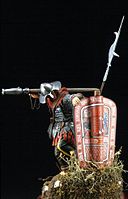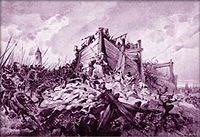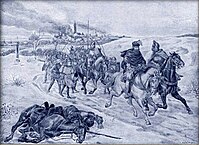Hussite Wars
The Hussite Wars, also called the Bohemian Wars or the Hussite Revolution, were a series of civil wars fought between the Hussites and the combined Catholic forces of Holy Roman Emperor Sigismund, the Papacy, and European monarchs loyal to the Catholic Church, as well as various Hussite factions. At a late stage of the conflict, the Utraquists changed sides in 1432 to fight alongside Roman Catholics and opposed the Taborites and other Hussite spin-offs. These wars lasted from 1419 to approximately 1434.
"Bohemian Wars" redirects here. For the later war over Bohemia, see Bohemian–Hungarian War (1468–1478).
The unrest began after pre-Protestant Christian reformer Jan Hus was executed by the Catholic Church in 1415 for heresy.[1][2] Because King Wenceslaus IV of Bohemia had plans to be crowned the Holy Roman Emperor (requiring Papal Coronation), he suppressed the religion of the Hussites, yet it continued to spread.[3] When King Wenceslaus IV died of natural causes a few years later, the tension stemming from the Hussites grew stronger. In Prague and various other parts of Bohemia, the Catholic Germans living there were forced out.
Wenceslaus's brother, Sigismund, who had inherited the throne, was outraged by the spread of Hussitism.[3] He received permission from the pope to launch a crusade against the Hussites, and large numbers of crusaders came from all over Europe to fight. They made early advances, forcing the Hussites back and taking Prague. However, the Hussites reorganized and took back nearly all the land they had lost, resulting in the failure of the crusade.
After the reins of the Hussite army were handed over to yeoman Jan Žižka, internal strife followed. Seeing that the Hussites were weakened, the Germans undertook another crusade but were defeated by Žižka at the Battle of Německý Brod. Three more crusades were attempted by the papacy, but none achieved their objectives. The Lithuanians and Poles did not wish to attack the Czechs, Germany was having internal conflicts and could not muster up a sufficient force to battle the Hussites, and the king of Denmark left the Czech border to go back to his home. As the conflicts went on, the Hussites also made raids into German territory.
The wars eventually ended in 1434 when the moderate Utraquist faction of the Hussites defeated the radical Taborite faction. The Hussites agreed to submit to the authority of the king of Bohemia and the Roman Catholic Church and were allowed to practice their somewhat variant rite.
The Hussite community included much of the Czech population of the Kingdom of Bohemia and formed a major spontaneous military power. The Hussite Wars were notable for the extensive use of early handheld firearms such as hand cannons and wagon forts by the Hussites.
Starting around 1402, priest and scholar Jan Hus denounced what he judged as the corruption of the church and the papacy, and he promoted some of the reformist ideas of English theologian John Wycliffe. His preaching was widely heeded in Bohemia, and provoked suppression by the church, which had declared many of Wycliffe's ideas heretical. In 1411, in the course of the Western Schism, "Antipope" John XXIII proclaimed a "crusade" against King Ladislaus of Naples, the protector of rival Pope Gregory XII. To raise money for this, he proclaimed indulgences in Bohemia. Hus bitterly denounced this and explicitly quoted Wycliffe against it, provoking further complaints of heresy but winning much support in Bohemia.
In 1414, Sigismund of Hungary convened the Council of Constance to end the Schism and resolve other religious controversies. Hus went to the Council, under a safe-conduct from Sigismund, but was imprisoned, tried, and executed on 6 July 1415. The knights and nobles of Bohemia and Moravia, who were in favour of church reform, sent the protestatio Bohemorum to the Council of Constance on 2 September 1415, which condemned the execution of Hus in the strongest language. This angered Sigismund, who was "King of the Romans" (head of the Holy Roman Empire, though not yet Emperor) and brother of King Wenceslaus of Bohemia. He had been persuaded by the Council that Hus was a heretic. He sent threatening letters to Bohemia declaring that he would shortly drown all Wycliffites and Hussites, greatly incensing the people.
Disorder broke out in various parts of Bohemia and drove many Catholic priests from their parishes. Almost from the beginning, the Hussites were divided into two main groups, though many minor divisions also arose among them. Shortly before his death, Hus had accepted the doctrine of Utraquism preached during his absence by his adherents at Prague: the obligation of the faithful to receive communion in both kinds, bread and wine (sub utraque specie). This doctrine became the watchword of the moderate Hussites known as the Utraquists or Calixtines, from the Latin calix (the chalice), in Czech Kališníci (from kalich). The more extreme Hussites became known as Taborites (Táborité), after the town of Tábor, which became their centre; or Orphans (Sirotci), a name they adopted after the death of their leader and general Jan Žižka.
Under the influence of Sigismund, Wenceslaus endeavoured to stem the Hussite movement. A number of Hussites led by Mikuláš of Hus left Prague. They held meetings in various parts of Bohemia, particularly at Sezimovo Ústí, near the spot where the town of Tábor was founded soon afterwards. At these meetings, they violently denounced Sigismund, and the people everywhere prepared for war.
In spite of the departure of many prominent Hussites, the troubles at Prague continued. On 30 July 1419, a Hussite procession headed by the priest Jan Želivský attacked New Town Hall in Prague and threw the king's representatives, the burgomaster, and some town councillors from the windows into the street (the first "Defenestration of Prague"), where several were killed by the fall, after a rock was allegedly thrown from the town hall and hit Želivský.[4] It has been suggested that Wenceslaus was so stunned by the defenestration that it caused his death on 16 August 1419.[4] Alternatively, it is possible that he may have just died of natural causes.
The outbreak of fighting[edit]
The death of Wenceslaus resulted in renewed troubles in Prague and in almost all parts of Bohemia. Many Catholics, mostly Germans—mostly still faithful to the Pope—were expelled from the Bohemian cities. Wenceslaus's widow Sophia of Bavaria, acting as regent in Bohemia, hurriedly collected a force of mercenaries and tried to gain control of Prague, which led to severe fighting. After a considerable part of the city had been damaged or destroyed, the parties declared a truce on 13 November. The nobles, sympathetic to the Hussite cause, but supporting the regent, promised to act as mediators with Sigismund, while the citizens of Prague consented to restore to the royal forces the castle of Vyšehrad, which had fallen into their hands. Žižka, who disapproved of this compromise, left Prague and retired to Plzeň. Unable to maintain himself there he marched to southern Bohemia. He defeated the Catholics at the Battle of Sudoměř (25 March 1420), the first pitched battle of the Hussite Wars. After Sudoměř, he moved to Ústí, one of the earliest meeting places of the Hussites. Not considering its situation sufficiently strong, he moved to the neighboring new settlement of the Hussites, called by the biblical name of Tábor.
Tábor soon became the center of the most militant Hussites, who differed from the Utraquists by recognizing only two sacraments—Baptism and Communion—and by rejecting most of the ceremony of the Roman Catholic Church. The ecclesiastical organization of Tabor had a somewhat puritanical character, and the government was established on a thoroughly democratic basis. Four captains of the people (hejtmané) were elected, one of whom was Žižka, and a very strict military discipline was instituted.
Late 14th and early 15th century saw gradually increasing use of firearms in siege operations both by defenders and attackers. Weight, lack of accuracy and cumbersome use of early types limited their employment to static operations and prevented wider use in open battlefield or by civilian individuals. Nevertheless, lack of guild monopolies and low training requirements led to their relatively low price. This together with high effectiveness against armour led to their popularity for castle and town defenses.[5]
When the Hussite revolt started in 1419, the Hussite militias heavily depended on converted farm equipment and weapons looted from castle and town armories, including early firearms. Hussite militia comprised mostly commoners without prior military experience and included both men and women. Use of crossbows and firearms became critical as those weapons didn't require extensive training, nor did their effectiveness rely on the operator's physical strength.[5]
Firearms were first used in the field as a provisional last resort together with wagon forts. Significantly outnumbered Hussite militia led by Jan Žižka repulsed surprise assaults by heavy cavalry during the Battle of Nekmíř in December 1419 and the Battle of Sudoměř in March 1420. In these battles, Žižka employed transport carriages as wagon forts to stop the enemy's cavalry charge. The main weight of the fighting rested on militiamen armed with cold weapons, but firearms shooting from behind the safety of the wagon forts proved to be very effective. Following this experience, Žižka ordered mass manufacturing of war wagons according to a universal template as well as manufacturing of new types of firearms that would be more suitable for use in the open battlefield.[5]
Throughout 1420 and most of 1421, the Hussite tactical use of wagon forts and firearms was defensive. The wagon's wall was stationary, and firearms were used to break the initial charge of the enemy. After this, firearms played an auxiliary role, supporting mainly cold weapons-based defense at the level of the wagon wall. Counterattacks were done by cold weapons-armed infantry and cavalry charges outside of the wagon forts.[5]
The first mobile use of war wagons and firearms took place during the Hussite breakthrough of Catholic encirclement at Vladař Hill in November 1421 at the Battle of Žlutice. The wagons and firearms were used on the move, at this point still only defensively. Žižka avoided the main camp of the enemy and employed the moving wagon forts in order to cover his retreating troops.[5]
The first true engagement where firearms played primary role happened a month later during the Battle of Kutná Hora. Žižka positioned his forces between the town of Kutná Hora, which pledged allegiance to the Hussite cause, and the main camp of the enemy, leaving supplies in the well-defended town. However uprising of ethnic German townsmen led the town into Crusader's control.[5][6]
Late in the night between 21 and 22 December 1421, Žižka ordered an attack against the enemy's main camp. The attack was conducted by using a gradually moving wagon wall. Instead of the usual infantry raids beyond the wagons, the attack relied mainly on the use of ranged weapons from the moving wagons. Nighttime use of firearms proved extremely effective, not only practically but also psychologically.[5]
The year 1421 marked not only a shift in the importance of firearms, from auxiliary to primary weapons of Hussite militia, but also the establishment of the Čáslav diet of formal legal duty for all inhabitants to obey the call to arms of the elected provisional government. For the first time in medieval European history, this was not put in place in order to fulfill duties to a feudal lord or to the church, but in order to participate in the defense of the country.[7]
Firearms design underwent fast development during the Hussite Wars, and their civilian possession became a matter of course throughout the war as well as after its end in 1434.[8] The word used for one type of handheld firearm used by the Hussites, Czech: píšťala, later found its way through German and French into English as the term "pistol".[9] The name of a cannon used by the Hussites, the Czech: houfnice, gave rise to the English term, "howitzer" (houf meaning "crowd" for its intended use of shooting stone and iron shots against mass enemy forces).[10][11][12] Other types of firearms commonly used by the Hussites included hákovnice, an infantry weapon heavier than píšťala and tarasnice (fauconneau). As regards cannons, apart from houfnice, Hussites employed bombarda (mortar) and dělo (cannon).
After the death of his childless brother Wenceslaus, Sigismund inherited a claim on the Bohemian crown, though it was then, and remained until much later, in question whether Bohemia was a hereditary or an elective monarchy, especially since the line through which Sigismund claimed the throne had accepted that the Kingdom of Bohemia was an elective monarchy elected by the nobles, and thus, the regent of the kingdom (Čeněk of Wartenberg) also explicitly stated that Sigismund had not been elected as a reason for Sigismund's claim to not be accepted. A firm adherent of the Church of Rome, Sigismund was aided by Pope Martin V, who issued a bull on 17 March 1420 proclaiming a crusade "for the destruction of the Wycliffites, Hussites and all other heretics in Bohemia". Sigismund and many German princes arrived before Prague on 30 June at the head of a vast army of crusaders from all parts of Europe, largely consisting of adventurers attracted by the hope of pillage. They immediately began a siege of the city, which had, however, soon to be abandoned. Negotiations took place for a settlement of the religious differences.
The united Hussites formulated their demands in a statement known as the "Four Articles of Prague". This document, the most important of the Hussite period, ran, in the wording of the contemporary chronicler, Laurence of Brezova, as follows:
These articles, which contain the essence of the Hussite doctrine, were rejected by King Sigismund, mainly through the influence of the papal legates, who considered them prejudicial to the authority of the pope. Hostilities therefore continued. However, Sigismund was defeated at the Battle of Vítkov Hill on July 1420.
Though Sigismund had retired from Prague, his troops held the castles of Vyšehrad and Hradčany. The citizens of Prague laid siege to Vyšehrad (see Battle of Vyšehrad), and towards the end of October 1420) the garrison was on the point of capitulating through famine. Sigismund tried to relieve the fortress but was decisively defeated by the Hussites on 1 November near the village of Pankrác. The castles of Vyšehrad and Hradčany now capitulated, and shortly afterwards, almost all Bohemia fell into the hands of the Hussites.
Second anti-Hussite crusade[edit]
Internal troubles prevented the followers of Hus from fully capitalizing on their victory. At Prague, a demagogue, the priest Jan Želivský, for a time obtained almost unlimited authority over the lower classes of the townsmen, and at Tábor, a religious communistic movement (that of the so-called Adamites) was sternly suppressed by Žižka. Shortly afterwards, a new crusade against the Hussites was undertaken. A large German army entered Bohemia and in August 1421 laid siege to the town of Žatec. After an unsuccessful attempt of storming the city, the crusaders retreated somewhat ingloriously on hearing that the Hussite troops were approaching.[13] Sigismund only arrived in Bohemia at the end of 1421. He took possession of the town of Kutná Hora but was decisively defeated by Jan Žižka at the Battle of Německý Brod on 6 January 1422.
Peace talks[edit]
The almost uninterrupted series of victories of the Hussites now rendered vain all hope of subduing them by force of arms. Moreover, the conspicuously democratic character of the Hussite movement caused the German princes, who were afraid that such ideas might spread to their own countries, to desire peace. Many Hussites, particularly the Utraquist clergy, were also in favour of peace. Negotiations for this purpose were to take place at the ecumenical Council of Basel which had been summoned to meet on 3 March 1431. The Roman See reluctantly consented to the presence of heretics at this council but indignantly rejected the suggestion of the Hussites that members of the Eastern Orthodox Church, and representatives of all Christian creeds, should also be present. Before definitely giving its consent to peace negotiations, the Roman Church determined on making a last effort to reduce the Hussites to subjection; this resulted in the fifth Crusade against the Hussites.
In popular culture[edit]
Andrzej Sapkowski's Hussite Trilogy is set in the Lands of the Bohemian Crown (mostly Silesia and Bohemia) during the Hussite Wars.
Dívčí Válka (2013), a manga series by Kouichi Ohnishi, focuses on a girl named Šárka who joins the Hussite Wars after the deaths of her family.[17][18][19]






